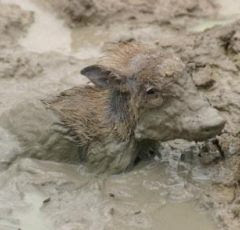Nelmo Ramos, a coffee producer in Guatemala, shows how roya is blighting their coffee crop
The culprit is the rising temperatures resulting from global warming that have caused catastrophe for those who depend on the region's most important cash crop: coffee. In the last two years, warmer temperatures and higher humidity levels have contributed to the spread of the roya - or coffee rust – a fungus that attacks leaves and fruits. Whole plantations have been destroyed and tens of thousands of campesinos have lost their jobs.
Roya, rust, blight by any name,.it's ugly. First, parts of the arabica bush's glossy green leaves turn a dirty orange. Then dark dead patches appear and become holes. The infection spreads to the ripening berries, turning them from bright red to a zombie-skin grey. However, the rust cannot survive temperatures below 10C. Until recently Roya usually occurred only below 1,300 metres. Up in the hills, cold nights and drier weather kept the disease at bay. And so that's where the coffee farms are.
This problem - habitat migration - isn't peculiar to coffee, the same thing is happening in our oceans where ocean chemistry is skewed by atmospheric carbon pollution driven global warming, some fish in the tropics are going extinct. Others, especially in northern latitudes, are migrating. In their place jellyfish are taking over in record numbers due to a global increase in ocean temperature and acidity (conditions in which jellyfish thrive) and the relentless overfishing of their predators.
Trees killed by the mountain pine beetle in B.C.'s Manning Park
It's called empirical evidence, and it's the non-ivory tower, non intellectual, direct and non-debatable reality that now threatens the cappuccino crowd. Up here in the Great White North both the gentrified Starbuckians and the plaid shirted Tim Horton's patrons had remained skeptical despite other direct evidence often choosing to focus on how global warming would cause a tourism boom in the Arctic, with melting ice-caps giving cruise ships increased access to the area or how many new oil and gas industry jobs there would be instead of acknowledging obvious evidence of human caused disaster like:
Arctic albedo decrease due to sea ice loss.
Arctic CO2 release due to thawing tundra.
Arctic methane release due to thawing land tundra.
Arctic methane release due to thawing subsea tundra and venting seabed methane.
Arctic albedo loss due to black carbon deposition.
Arctic albedo loss due to land vegetation changes.
Warming Arctic seas due to runoff from warming lands.
Arctic albedo decrease due to land snow and ice sheet melt.
But those days have passed now that there's a new terrorist in town - no coffee. You'd think this moving pictorial essay from the Guatemalan highlands and Nicaragua's Jinotega hills, where starving villagers desperately struggle to save their lives and their livelihoods, would normally be expected to cause a minor ripple among the consumer class, but now, under the threat of global warming's new terrorists i suspect even the caffeine culture's most ardent skeptics will rise up and fight for their Java Buzz.




